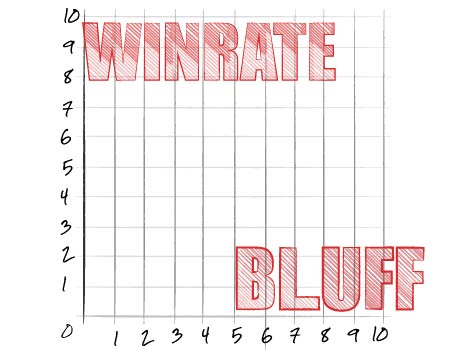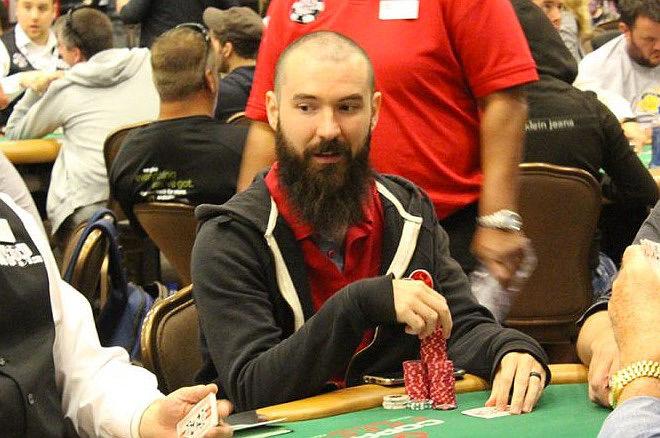Poker Optimal Bluffing Frequency
This maps pretty well to a poker bluffing scenario on the river. You either have the nuts 50% of the time, or the worst possible hand the other 50%. This only covers whether Player 1 should bluff and whether Player 2 should then call. Player 2 doesn't have the option to bet if you check, raise if you bet, and the bluff amount is fixed.

Poker Optimal Bluffing Frequency Definition
I’ve been toying around with this situation for a while, and although I want to retain some measure of caution simply because I have a history of making mistakes with this sort of thing, I’m pretty sure I’ve determined that the optimal bluffing frequency for Hero doesn’t change even if Villain has some monsters in his range.
Poker Optimal Bluffing Frequency Analyzer
Optimal Bluffing Frequency Watching Leforts advanced theory topics and I have a question regarding optimal bluffing frequency. It's mentioned that for a 1/2ps bet the optimal amount is 25% (0.5/(0.5.2 + 1)). The blinds are 100/200. Effective stacks are 20K. Hero opens the button to 600. Hero is opening a game theory optimal range of 35.1%. Villain is defending by calling with a game theory optimal range of 24.6% of hands. K♠ 7♥ 2♣ Villain checks. Villain needs to check-call about 67% of the time.
The critical thing is that Villain have enough non-nut hands in his range on the turn to make bluffing profitable for Hero. In the hand that I posted, double-barrel bluffing for pot-sized bets on the turn and river will see Hero risking about 2800 to win about 700, or 4 units to win 1. To make Hero indifferent to bluffing, Villain needs to check-call twice with 25% (1 out of every 4 combos) or his range.
If Villain calls with more bluff-catchers than that, Hero can exploit him by never bluffing, in which case Villain will pay off Hero’s nuts too often. If he calls with fewer bluff-catchers, Hero can exploit him by bluffing all of his non-nut hands. The latter requires that Hero actually have bluff candidates in his range, a point to which we’ll return in a moment.
Because this bluff stretches over two streets, Villain needs to make Hero indifferent to two distinct bluffing lines: the single barrel and the double barrel. This requires Villain to call a pot-sized bet with at least half of his range on the turn, and then half again of that range on the river. So not only must Villain take 25% of his range to showdown, but he must take an additional 25% to the river or risk exploitation from a player who bluffs the turn and then gives up on the river.
The bottom line here is that if the nuts make up more than 25% of Villain’s range, Hero should never bluff. Similarly, Villain should never bluff-catch. This makes intuitive sense: I’ve often advised that you should fold bluff-catchers when you have many stronger hands in your range. Your opponents can’t profitably, and won’t generally try to, bluff into you when you could easily have a monster.
If Hero can polarize his range such that more than 25% of Villain’s range becomes bluff-catchers, then he can profitably bluff even if 24% of Villain’s range were nutted. The optimal frequency for doing so is just as Sklansky described in his article. On the river, Hero can bluff half as many hands as he has combos of the nuts (the nuts here referring to any hand with 100% equity against Villain’s bluff-catching range). On the turn, Hero should bet all of his nut hands, all of the hands he will bluff on the river, plus another x hands, where x is one-half the total number of combos he will bet on the river. The more combos of the nuts Villain has in his range, the less profitable this strategy will be for Hero, but as long as Villain doesn’t have the nuts more than 25% of the time, Hero is better off bluffing in a balanced way than not bluffing at all.

Finding More Bluffs
The complication in my example is that Hero may actually not have enough non-nut hands in his range to execute this strategy. If we assume that Hero’s range after seeing the turn card is {A9s,Q9s,J9s,T9s,98s,97s,96s,87s,66}, ie 7 nutted combos, 4 open-ended straight draws, and 3 counterfeited boats, he should bet 100% of his range on the turn, and Villain should nonetheless fold whenever he doesn’t have the nuts. (You might notice another complication in this last sentence, that I’ll return to at the end of this post.)
If Hero plans on shoving the river optimally, meaning with 7 combos of the nuts and 3.5 combos of bluffs, then he can profitably bet 6 additional combos of bluffs on the turn with which he will give up on the river. However, the above range gives Hero only 3.5 additional combos with which to bluff the turn. Thus, Hero should strongly consider turning hands with showdown value into bluffs if he has any. If, for instance, Hero cold calls the flop raise with a hand like 88, he should occasionally turn these hands into bluffs rather than trying to check them down and win against Villain’s flop bluffing range. (The question of how, if at all, to balance Hero’s checking range is beyond the scope of this post.)


Another minor point I’ve ignored is that some of Hero’s bluffs provide blockers to Villain’s nut combos. For example, when Hero has 8d 7d, his opponent can’t have 9d 8d. Bluffing somewhat more often with this hand would probably be profitable, but it’s a minor effect and I haven’t taken the effort to calculate it.
I’ve also ignored the possibility of Villain doing anything other than checking and either calling or folding, since betting or check-raising both seem to be dominated strategies, and the possibility of Hero using any sizing other than pot-sized bets on both streets, which I’ll address in a moment.
The main point here is to demonstrate the importance, against good players/hand readers, of being able to show up with weak hands in unexpected spots.
An Unresolved Problem
Poker Optimal Bluffing Frequency Examples
There’s one thing I still haven’t resolved, that I’ll try to sort out and post here when I do. If Villain is correct, against Hero’s extremely nutted range, to fold all of his bluff-catchers on the turn, then Hero can exploit this by bluffing the turn and giving up on the river. However, Villain could exploit that by calling the turn and folding the river with all of his bluff-catchers, which Hero could exploit by double-barreling all of his bluffs, which Villain could exploit by folding all of his bluff-catchers on the turn…. Basically I’m not sure yet what would be the equalibrium strategy in the event that the nuts comprise more than 4/9 of Hero’s range, which is the point at which he can profitably bet-shove his entire range.
Poker Optimal Bluffing Frequency Calculator
My suspicion is that Hero can make the most of this situation by betting less than pot on the turn. This enables him to lose less on his bluffs while still putting sufficient pressure on Villain’s bluff-catching range. If he can do is in a balanced way, though, Hero’s optimal line is to pot both the turn and river.